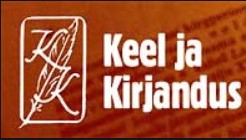Maastik kui inimoluruum eesti keeles
Landscape as space for human beings in Estonian
Author(s): Mari Uusküla, Anu Vau, Kaidi Rätsep, Hannes PalangSubject(s): Semantics, Descriptive linguistics, Finno-Ugrian studies, Environmental interactions
Published by: SA Kultuurileht
Keywords: semantics; vocabulary; folk taxonomy; list task; cognitive salience index; semi-structured interview;
Summary/Abstract: When we study the organisation of space, one possibility is to talk about landscape as every human being is surrounded by landscape at all times (Burenhult and Levinson 2008). This is the first attempt to describe the language of landscape in Estonian. We used list task questions and semi-structured interviews as combined methods. 124 participants took part in the first part of the study (74 school-children, 7 students and 42 teachers or university professors, 80 female) where nine questions were asked under time pressure (30 seconds). All were adapted from Smith and Mark (2001). Here we report on the answers given to two list task questions: “a kind of geographic feature” and “something geographic”. We analyse the data with the cognitive salience index (Sutrop 2001) and construct a hierarchy of prototypical landscape terms using the prototype theory (Rosch 1975). Surprisingly for a people surrounded mostly by flat land the most prototypical landscape term is mägi ‘mountain, hill’, followed by küngas ‘hill’, puu ‘tree’ and kivi ‘stone’. The word describing flat land – lagendik – was much less frequent and therefore belongs to the periphery of landscape terms. In the second part of the study we asked 13 participants to describe what maastik ‘landscape’ is for them. We adapted the methodology of Berlin (1992) of his ethnobiological classification and treated maastik as the unique beginner. We constructed the folk taxonomy of maastik and compared it with the taxonomy constructed by an expert (co-author Hannes Palang). The results reveal that if experts divide landscape into natural and human-influenced landscape, laypersons rarely talk about human-influenced forms of landscape such as parks, cities, streets, etc. We conclude that landscape in Estonian seems to be something natural and rather untouched by human beings. The high cognitive salience index of mägi reveals that landscape could be considered as something that can be viewed and admired from far away (Cresswell 2004).
Journal: Keel ja Kirjandus
- Issue Year: LXIII/2020
- Issue No: 8-9
- Page Range: 659-676
- Page Count: 18
- Language: Estonian

